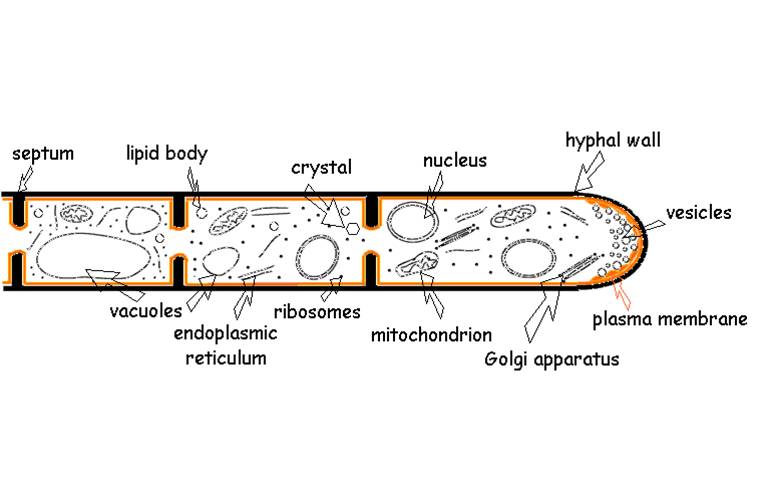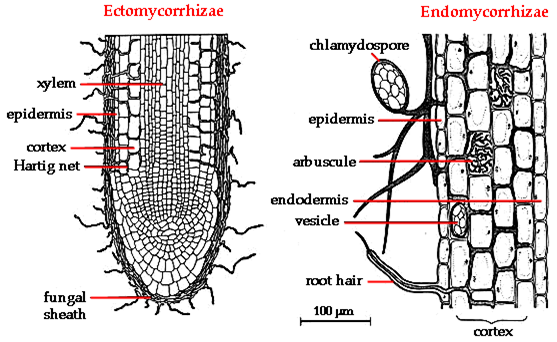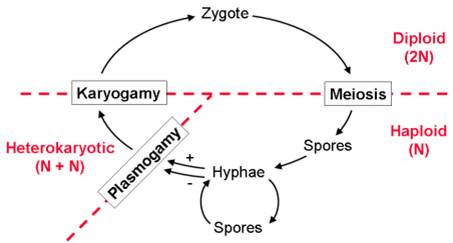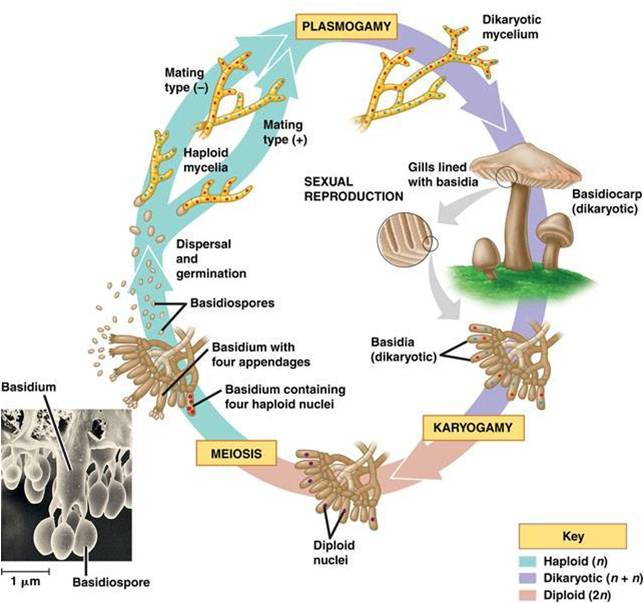 IV.
The Domain Eukarya
IV.
The Domain Eukarya  IV.
The Domain Eukarya
IV.
The Domain Eukarya 1. Overview:
The Opisthokonts are the eukaryote clade that includes organisms with a single posterior flagellum at some part of their life cycle. This includes the fungi, choanoflagellates, and animals. Only the most primitive group of fungi - the chytrid fungi - still have a flagellated life history stage today. Other fungi have evolved so that the spore is the dispersive life history stage.
 2.
"Body Plan"
2.
"Body Plan"
Fungi are very diverse, with over 100,000 named species. Although some fungi are unicellular (the "yeasts" - which are a diverse group taxonomically but are lumped together under this name because of their unicellular structure), most are multicellular - but with an interesting twist. The 'multicellular' fungi have a body composed of thin threads called hyphae. Hyphae have a cell wall composed of chitin - the same polysaccharide in arthropod exoskeltons. But in most species, the hyphae are not composed of discrete cells. Rather, the hyphal strand consists of multinucleate cytoplasm. In some species, there are "cell walls" called septa that subdivided the hyphal strand, but they have holes large enough to exchange mitochondria and cytoplasm. Other fungi don't even have septa. So, the cytoplasm 'streams' quickly along the length of the hyphal organism. Therefore, nutrients absorbed by one part of the fungus can be transmitted quickly through the organism. Fungi can grow very rapidly, literally growing towards nutrients concentrated in the soil or benthos. The earliest fossils that have fungal-like characteristics date to 1.4 bya, suggesting that the fungi diverged from the other opisthokont lineages early in eukaryote evolution. These fossils have septa and form a network of filaments - characteristics of many fungi we see today.
 3.
Ecological Roles
3.
Ecological Roles
Fungi are absorptive heterotrophs; they secrete enzymes into the immediate environment of the hyphae and absorb the products of that extracellular digestion. Fungi are a diverse group that play many important and interesting roles in the environment. Many digest dead material - these are the decomposers. Fungi are the primary decomposing organisms in almost all environments on earth, including marine, freshwater, and terrestrial habitats. However, as obligate aerobes, they do not perform well in anaerobic environments - in those places, anaerobic bacteria are the only decomposing organisms.
Other fungi digest living material - these are the parasitic fungi like those that cause athlete's foot, ringworm, and vaginal yeast infections (Candida albicans). Other organisms are infected by fungi, of course; indeed, fungal infections of plants called rusts, smuts, mildews, and ergots can kill the host plant and are important pathogens of crop plants. Humans and other animals that consume seeds or tissue infected with ergots can suffer hallucinations, siezures, miscarriage, and death. Chytrid fungi are significant pathogens of amphibians. Amphibian populations are crashing worldwide, probably due to a combination of global warming, habitat degradation, pollution, and the spread of chytrid fungus. Another interesting group of fungi are the 'entomophagous' fungi. Spores land on insects and germinate - boring a hole through the exoskeleton. Once inside, they digest the animal and complete their life cycle, producing spore-bearing bodies that erupt through the insects dead body. Interestingly, seelction has favored fungi that attack the nervous system last, and in a particular way - making the insects more positively phototaxic. The insects climb towards light and then die - placing the fungus above the ground where spore dispersal is more effective. There are also predatory fungi, like Arthrobotrys anchonia. This soil fungus has hyphal 'lariats'. When soil nematodes wriggle through the loop, the hyphae shunt water to the loop and it swells quickly- clamping down on the nematode. The worm is then digested. Given the extraordinary abundance of nematode worms in the soil (several thousand per cubic cm), they are a ready foodstuff for anything that can catch them - even fungi.
 Other
important fungi enter into mutualistic relationships with alga and plants. Lichens
are symbiotic relationships between algae or cyanobactera and particular species
of fungi; the photosynthetic algae or cyanobacteria provides carbon and energy
(in the form of sugars) to the fungus through photosynthesis, and the fungus
absorbs water and mineral nutrients (N and P) required by the algae. Similar
symbiosis occur between vascular plants and a particular group of fungi, the
Glomerales (or Glomales). This clade of fungi are root symbionts of plants,
forming symbiotic relationships called mycorrhizae. There are two types of associations.
In ectomycorrhizal associations, the fungus covers the fine roots and root hairs
of a plant like a shealth, with only minor incursions of fungal hyphae into
the root, itself. In the arbuscular mycorrhizal fungi, the fungi grow specific
structures within the root, forming a much more intimate relationship. Because
hyphae are so small, they have a huge absorptive surface area per unit volume;
much greater than bulkier plant roots. And, by secreting enzymes into the soil,
they can mobilize nitrogen and phosphorus. Finally, because they grow rapidly,
they can quickly colonize areas where nutrients are available. Hyphae absorb
water and mineral nutrients and pass them to their symbiotic plant partner in
exchange for sugars that contain the energy and carbon that the fungus needs
to thrive. Over 70% of all vascular plant families have species that form mycorrhizal
symbioses with fungi. Apparently, this is a very ancient relationship, dating
back to the evolution of vascular plants. The oldest vascular plant fossils
(from the Rhynie chert - 420 mya) have fungal endosymbionts. It may be that
the evolution of mycorrhizae allowed plant to colonize land in the first place.
Other
important fungi enter into mutualistic relationships with alga and plants. Lichens
are symbiotic relationships between algae or cyanobactera and particular species
of fungi; the photosynthetic algae or cyanobacteria provides carbon and energy
(in the form of sugars) to the fungus through photosynthesis, and the fungus
absorbs water and mineral nutrients (N and P) required by the algae. Similar
symbiosis occur between vascular plants and a particular group of fungi, the
Glomerales (or Glomales). This clade of fungi are root symbionts of plants,
forming symbiotic relationships called mycorrhizae. There are two types of associations.
In ectomycorrhizal associations, the fungus covers the fine roots and root hairs
of a plant like a shealth, with only minor incursions of fungal hyphae into
the root, itself. In the arbuscular mycorrhizal fungi, the fungi grow specific
structures within the root, forming a much more intimate relationship. Because
hyphae are so small, they have a huge absorptive surface area per unit volume;
much greater than bulkier plant roots. And, by secreting enzymes into the soil,
they can mobilize nitrogen and phosphorus. Finally, because they grow rapidly,
they can quickly colonize areas where nutrients are available. Hyphae absorb
water and mineral nutrients and pass them to their symbiotic plant partner in
exchange for sugars that contain the energy and carbon that the fungus needs
to thrive. Over 70% of all vascular plant families have species that form mycorrhizal
symbioses with fungi. Apparently, this is a very ancient relationship, dating
back to the evolution of vascular plants. The oldest vascular plant fossils
(from the Rhynie chert - 420 mya) have fungal endosymbionts. It may be that
the evolution of mycorrhizae allowed plant to colonize land in the first place.
 4.
Fungal Life Cycle
4.
Fungal Life Cycle
Fungi have a distinctive life cycle that includes an unusual 'dikaryotic' or 'heterokaryotic' cell type that has two nuclei. The life cycle begins when a haploid spore germinates, dividing mitotically to form a 'multicellular' haploid organism (hypha). In most fungi, hyphae can produce spores directly, through an asexual process (mitosis). Hyphae belong to different sexual types, represented by their ability to "mate". When different mating types contact one another, the cytoplasm of the hyphae fuse but the nuclei remain separate. This process is called 'plasmogamy', and it creates an initial cell called a 'dikaryon'. If it divides to produce multicellular tissue, both nuclei divide and are passed on to both daughter cells - creating dikaryotic ( 'heterokaryotic' in the figure) tissue. Eventually the nuclei fuse, creating a true diploid cell ("zygote"). This cell undergoes meiosis, producing haploid spores that are dispersed to the environment.
5. Fungal Diversity
There are four main groups of fungi, largely distinguished by their reproductive structures.
 Chytridomycota:
Again, this is the most primitive group of fungi that maintain a flagellated
life history stage. Not surprizingly (having a flagellated stage), most forms
are aquatic - again representing the ancestral condition in the kingdom. The
life cycle of chytrid fungi is quite unique. Perhaps the best place to start
is with the union of isogamous, flagellated gametes. This produces a flagellated
zygote that encysts. From this cyst, a diploid hypha grows. This diploid hypha
produces a "zoosporangium" - a reproductive structure. The cells in
that structure can undergo mitosis or meiosis. If they divide mitotically, diploid
flagellated zoospores are produced that can encyst elsewhere and propagate more
diploid mycelium. If they divide meiotically, then haploid flagellated zoospores
are produced that encyst and produce haploid mycelium. This haploid mycelium
produces male and female "gametangia", that produce isogamous, flagellated
gametes by mitosis. So, the chytrid fungi are interesting in having both diploid
and haploid hyphae, and diploid and haploid flagellated life history stages.
Chytridomycota:
Again, this is the most primitive group of fungi that maintain a flagellated
life history stage. Not surprizingly (having a flagellated stage), most forms
are aquatic - again representing the ancestral condition in the kingdom. The
life cycle of chytrid fungi is quite unique. Perhaps the best place to start
is with the union of isogamous, flagellated gametes. This produces a flagellated
zygote that encysts. From this cyst, a diploid hypha grows. This diploid hypha
produces a "zoosporangium" - a reproductive structure. The cells in
that structure can undergo mitosis or meiosis. If they divide mitotically, diploid
flagellated zoospores are produced that can encyst elsewhere and propagate more
diploid mycelium. If they divide meiotically, then haploid flagellated zoospores
are produced that encyst and produce haploid mycelium. This haploid mycelium
produces male and female "gametangia", that produce isogamous, flagellated
gametes by mitosis. So, the chytrid fungi are interesting in having both diploid
and haploid hyphae, and diploid and haploid flagellated life history stages.
Zygomycota: These fungi are mostly terrestrial and are often parasites or decomposers. The black bread mold, Rhizopus, is the typical exemple. Haploid spores germinate and produce hyphae. These hyphae are capable of forming sporangia and spores asexually by mitosis. Hyphae can also reproduce sexually, by encountering a hypha of another sex type. Fusion of hyphae creates a zygosporangium - tissue with dikaryotic "cells". Eventually the nuclei fuse in to zygote (diploid) nuclei. These proceed through meiosis, producing haploid spores.
Ascomycota: These are the 'cup' fungi that bear their spores in a structure called an ascus. The haploid spore germinates and haploid hyphae are produced. The hyphae can produce spores asexually, or they can mate - creating heterokaryotic tissue. This heterokaryotic tissue divides and produces heterokaryotic hyphae that forms a reproductive mass similar to an inverted or pock-marked mushroom. These are the cups of cup fungi or the fruiting bodies of morel "mushrooms". At the end of each hyphae in the reproductive body, the nuclei finally fuse - creating the ascus. The nuclei proceed through meiosis, producing haploid spores released from the fruiting body. Baker's and Brewer's yeasts are unicellular ascomycetes.
Basidiomycota: The basidiomycota are the most derived group, having lost the capacity to reproduce asexually. Spores germinate and produce hyphae. Haploid hyphae fuse, forming dikaryotic haphae. These dikaryotic hyphae can form a reproductive structure (basidiocarp or "mushroom"), and at the end of each dikaryotic hyphal strand the nuclei fuse within the last cell (basidium). The nucleus proceeds through meiosis, forming haploid spores that are released from the mushroom. This is a very diverse group that includes the rusts and smuts beside the mushroom producing fungi that you are familiar with.
 Study
Questions:
Study
Questions:
1. List the three groups in the Opisthokonts.
2. How do fungi acquire energy? How does their odd cellular structure complement their metabolism?
3. Fungi are primary decomposers. What other group of organisms are decomposers? What chemicals do these groups produce to kill one another (we use these chemicals to kill bacteria and fungi, too!)
4. Describe an example where fungi act as a predator, pathogen, and parasite.
5. What are mycorrhizae, and why are they so important?
6. Draw a generic fungal life cycle. What is novel about this life cycle - what type of tissue is produced that is unusual?